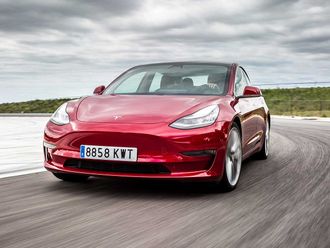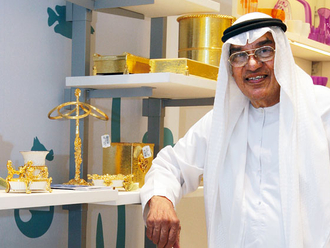
Nissan's perennial Patrol has roots going back to the original 4W60 series all-purpose vehicle launched in 1951 for the central Asian market, but it didn't reach the Middle East until 1957. By then, it was into its third generation, and it has been unstoppable ever since. Not for nothing is the Patrol a favourite of the aid agencies, peace-keeping forces and various organisations operating in some of the most remote and demanding locations on the planet.
Key to that popularity was the Patrol's rugged construction and go-anywhere ability, and it carried on relentlessly doing what it was designed to do.
Trouble is, this is 2010, and most of today's Patrols spend their time stuck in traffic jams on the way to the supermarket. The back seats are now filled, not with blue-hatted peacekeepers, but with pink princesses and football-kitted youngsters headed for party or game.
Rugged construction and off-road prowess count for little with the valet parker, and Nissan knew it. Priorities have changed and SUV drivers now want luxury, performance and comfort on top of the knowledge that they can romp up to the top of Big Red without breaking sweat, if they ever wanted to.
Fact is, Nissan's acknowledged main competitor, the Toyota Land Cruiser, had long ago recognised this shift and has been cleaning up the market.
Never a company to give in to a fight, Nissan began development of its answer as early as 2004 with a revised platform, engine and transmission, but it was a further two years later that the New Patrol project was officially launched.
Half a billion dollars later and this is the result. In many ways, it's a very different car to the outgoing Patrol, though there is a degree of ‘Patrol-ness' in the DNA that keeps it recognisable. Have they succeeded? wheels was among the first to find out, during an extended test drive on the highways and byways south of Muscat in Oman.
Sands of change
First impressions are that, visually at least, this is a major change of direction. Almost the only familiar element in the design is the big ‘angled strut' motif framing the grille. It's still there, but that's about it.
Gone are the old edgy and macho looks; instead, much softer and rounded lines are intended to suggest a more spacious and luxurious vehicle.
Gone, too, is the old split tailgate, replaced with a top-hinged and powered liftgate. Everything is new — lights, C-pillar, wheels — and the familiar high front bumper has been replaced by a new deep-chinned look driven by pedestrian protection legislation. (I suspect it will be the first thing to go when the desert safari companies get their hands on this Patrol.)
Another exclusion is the old solid rear axle. This new Patrol is a fully independent suspension job, though it does retain the old car's ‘body-on-frame' construction. In fact, the new chassis is said to be much stiffer than the outgoing version and was specifically developed to allow the introduction of ‘Hydraulic Body Motion Control' to improve the Patrol's on-road behaviour.
Under that high, curvy new bonnet is a brand new 5.6-litre V8, up from the old 4.8, and now boasting both variable valve timing and lift as well as direct fuel injection. The result is a generous 400bhp and a full 560Nm of torque, which help disguise the Patrol's considerable weight.
If you want bragging rights, tell your mates that it was built in the same factory that produces the engine for the GT-R. Or simply feel virtuous because it is both cleaner and more economical than the old one.
Mated to this lump is an all-new seven-speed automatic transmission, which does have a manual shift mode using the lever, but no steering wheel paddles or buttons. Nissan has kept the low ratio box and the whole lot is now controlled by the same electronics as found in the GT-R. Except that the GT-R doesn't boast settings for Sand and Rock in addition to its On-Road mode.
Silent witness
On the road, first impressions are that the new Patrol is very, very quiet. Noise suppression is superb — there's virtually nothing transmitted from the tyres, the suspension soaks up bumps and thumps without a murmur and wind noise only starts to become apparent at the sort of speeds that could jeopardise your licence. You can hear the engine, but only when it revs willingly and pulls hard.
The next thing you notice is how well it corners. Body roll is eerily absent through bends and roundabouts and it's only the howls of protest from the road-biased tyres that tell you how hard you're cornering. In fact, the new Patrol drives and feels just like the sportscar it isn't, which is quite entertaining for something so heavy.
Tellingly, we have no actual audited performance figures yet, so Nissan's claim that the new Patrol is ‘the fastest SUV in the class' will have to remain just that; a claim.
But if its on-road performance is impressive, what of the rough stuff? Going for an all-independent suspension system configuration has allowed for a high degree of articulation, which in turn means better traction as all four wheels remain in contact with the ground.
We drove over a wide range of surfaces and the system certainly seemed to cope well. I have reservations about the lightness and feedback of the steering, preferring a more communicative set-up that really tells you what each wheel is doing and the grip available. It was all a bit PlayStation; turn the wheel and change the view.
However, we did get a chance to do some fairly serious scrabbling down a long and occasionally flooded wadi bed. Fording a fast-flowing stream, you could feel the transmission searching for grip among the very tricky river-washed pebbles and though it struggled, it never got stuck. Perhaps a simple old-fashioned diff lock would have been a better alternative in the hands of a skilled driver, but here the electronics got us through.
Next up was, well, up — a chance to try out the Patrol's hill climbing ability with a romp up Jebel Al Jabar. This was a track scratched up the side of an impossibly steep escarpment. The Patrol climbed it without protest.
There's another of those bits of electronic trickery buried in the gearbox, a Hill Start Assist feature which will hold the Patrol on any slope if you come to a halt, even if you take your foot off the brake pedal. In this way, you can concentrate on correct throttle control without having to worry about rolling back.
Still, we made it up the ear-popping ascent and after a spot of lunch in the thoughtfully provided rest camp, it was time to retrace our steps. This was our opportunity to sample Hill Descent Control. Actually, the computer lets you roll downhill at a maximum of 7kph in Hi and 4kph in Lo range, and it was fun listening to the computer juggling brake pressure to take us down slowly. It all felt a bit glacial, so we were glad to get back on the gravel at the bottom and disengage the electric nanny.
Verdict
And that pretty much sums up my impression of the new Patrol. It is a feature of many modern cars that electronics have taken over where driver skill was once required and the Patrol is certainly very effective in coping with conditions that would have severely tested my own experience.
It is sports-car fast on the open road, as spacious and comfortable as a big saloon and has enough mountain climbing ability to put a local goat to shame. I have no doubt that for people wanting a modern SUV loaded with all the latest bells and whistles, this seventh generation Patrol will tick an awful lot of boxes.
This is the state of the art expression of SUV, period. It is a very definite change of direction from the old Patrol, and I have no doubt at all that it will find Nissan a lot of new fans.
But I guess I must be getting old, because I still long for something strong, simple and mechanical, that will get you to the ends of the earth and back, and if it breaks, can be fixed with a hammer, not a laptop.
Specs & rating
- Model: 2010 Nissan Patrol
- Engine: 5.6-litre V8
- Transmission: Seven-speed automatic
- Max power: 400bhp @ NA
- Max torque: 560Nm @ NA
- Top speed: NA
- 0-100kph: NA
- Price: Dh179,500 (base)
- Plus: Extremely capable off- roader, luxury features
- Minus: Light steering











